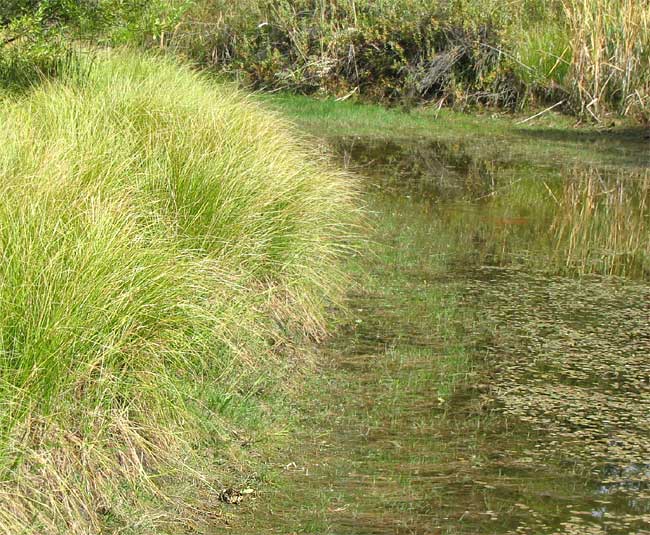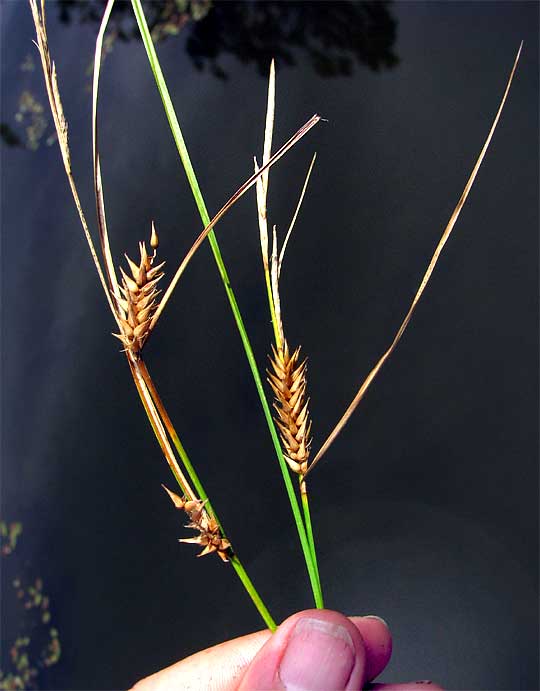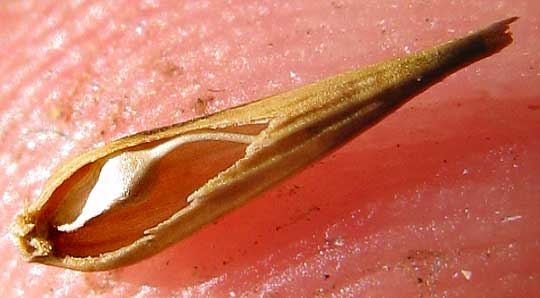Excerpts from Jim Conrad's
Naturalist Newsletter

from the the September 20, 2009 Newsletter, issued from the Siskiyou Mountains west of Grants Pass, Oregon:
THE POND'S SEDGY BANKS
Much of the pond above my trailer is attractively bordered with a lush, dense, thigh-high mantle of grasslike growth, a small part of which is shown above. You look in vain for grass inflorescences or fruiting heads rising above the arching blades, but if you part the blades, inside them at mid-level you'll indeed find inflorescences, two of which are shown below:

You might recognize these as being produced by a kind of sedge, genus Carex, which are not members of the Grass Family, but rather of the big Sedge Family. If you've looked into sedges probably you know that there's a lot of them, and that they can be a challenge to identify. In the Manual of Vascular Plants of Northeastern United States and Adjacent Canada, 1991 edition, Carex is the largest of all genera, embracing 230 species, and it's a similarly sedgy situation here in the Northwest.
In the above photo the flower arrangement is typical. Male flowers are restricted to three or so slender, silvery flower spikes at the inflorescence top, while female flowers are spirally arranged in much thicker, brown spikes below the male ones. A close-up of a spike of female flowers, showing sharp bracts beneath each sac-like, teardrop-shaped item (the perigynium), is below:

Each perigynium is mostly filled with empty air, but inside and at the bottom of each there's a tiny, three-angled fruit of the achene type (dry, single seeded fruit not splitting at maturity), as shown below:

That achene is topped by a slender, more or less persistent style, which is the "neck" connecting the former ovary with its pollen-collecting stigma, which protruded through the perigynium's open, chimney-like "neck."
You can imagine how such perigynia function. They fall off the flowering stalk, land in water, and float to a distant shore. There they decay or are torn open by a duck or something, and next spring the achene that floated inside it germinates to form a new sedge.
*UPDATE: In 2009 I wrote that this sedge was particularly easy to identify, but in 2024 I see that it's not the commonly occurring and broadly distributed Carex vesicaria, which I thought it was, but rather the very closely related and similar CAREX EXSICCATA, known as the Western Inflated Sedge. Apparently in 2009 my sources didn't consider this species. The error became apparent when in 2024 I uploaded the images and information to the wonderful iNaturalist website, where two users familiar with the area, "brucen" and "steinm," recognized Carex exiccata.
Carex exiccata is described as inhabiting lake, pond, and river shores, marshes and sedge meadows, often in shallow water, exactly as shown in the pictures. It's distributed from southern British Columbia south to northwestern California. The 2021 study by Brooke and Denise Arkush entitled "Aboriginal plant use in the central Rocky Mountains: Macrobotanical records from three prehistoric sites in Birch Creek Valley, eastern Idaho" reports that indigenous people in the area formerly used its roots for making a black dye.